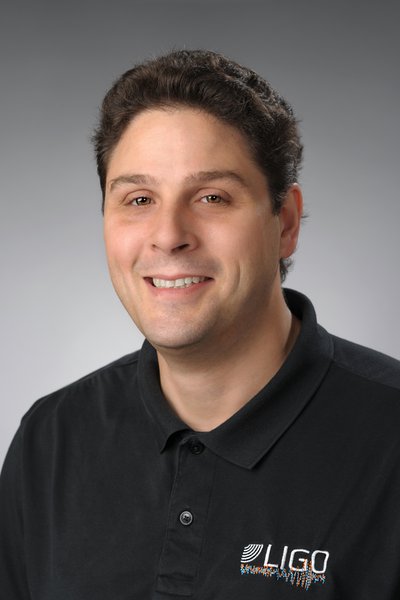Stefan Ballmer

Stefan Ballmer
Professor
CONTACT
Physics
263-5 Physics Building
Email: sballmer@syr.edu
Office: 315.443.3882
Degrees
- 2006 Ph.D. in Physics, Massachusetts Institute of Technology
- 2000 Diploma in Physics, with honors in Theoretical Physics, Swiss Federal Institute of Technology (ETH) - Zurich
Social/Academic Links
- Third-generation gravitational-wave detector technology.
- Quantum control of macroscopic objects.
- Commissioning of Advanced LIGO.
Searching for a stochastic background of gravitational waves with Advanced LIGO.
Research Spotlight

The Syracuse University Gravitational Wave Group is working to detect gravitational waves with the Laser Interferometer Gravitational-wave Observatory (LIGO).
(Oct. 10, 2023)
Researchers from the University’s new Center for Gravitational Wave Astronomy and Astrophysics are at the intellectual center of the next-generation observatory.
(Sept. 25, 2023)
The new center officially launched with an opening ceremony featuring distinguished speakers from Harvard, MIT and Princeton.
(Aug. 28, 2022)
The grant will establish a pathway to success for physics graduate students from underrepresented groups.
(Aug. 19, 2022)
Professor Stefan W. Ballmer and his students are collaborating with researchers from MIT to increase detector sensitivity – a key to observing some of the Universe’s most energetic events.
(Oct. 14, 2021)
The APS recognized Ballmer for his role in designing gravitational-wave detectors and interpreting their observations.
(June 12, 2020)
Using observations of neutron star collisions, Professor Duncan Brown will study the nature of matter.
(Oct. 16, 2017)
Professors Saulson, Brown, Ballmer trace origins of gold and heavy metals to neutron star collisions
(Oct. 2, 2017)
Peter Saulson, Duncan Brown, and Stefan Ballmer played a lead role in the analysis of Gravitational wave signals as part of the multinational Laser Interferometer Gravitational-Wave Observatory (LIGO)
(June 1, 2017)
Alex Nitz G'15 helped detect gravitational-wave signal with software he began developing at Syracuse
(May 17, 2017)
Syracuse physicist part of $600,000 grant to more accurately measure gravity
(Aug. 19, 2016)
Professors Duncan Brown, Stefan Ballmer use NSF grant to help recruit, train students from underrepresented groups
(June 15, 2016)
LIGO detects second pair of colliding black holes
(May 25, 2016)
Gravitational Wave Group honored for contributions to physics, astronomy
(Feb. 11, 2016)
LIGO Opens New Window on the Universe with Observation of Gravitational Waves from Colliding Black Holes
(Feb. 11, 2016)
Finding coincides with 100th anniversary of Einstein's Theory of Relativity (VIDEO)
(Sept. 17, 2015)
Physicists participate in first run of new Advanced LIGO Detector, after five-year rebuild
(May 27, 2015)
Physics department has been leading the search for gravitational waves for more than 25 years
Syracuse, Cal State Fullerton Awarded Grant to Enhance Diversity in Astrophysics
Syracuse Physicists among Recipients of Breakthrough, Gruber Prizes
Gravitational Waves Detected 100 Years after Einstein’s Prediction
Four SU professors receive prestigious ‘CAREER’ awards from National Science Foundation
- Robert A. Millikan Postdoctoral Prize Fellowship for Experimental Astrophysics (2006), California Institute of Technology
- Honorable Mention, GWIC (Gravitational Wave International Committee) Thesis Prize (2006)
J. Abadie et.al. , "Directional limits on persistent gravitational waves using LIGO S5 science data", Phys. Rev. Lett. 107, 271102 (2012).
S. Ballmer, S. Marka, P. Shawhan, "Feasibility of measuring the Shapiro time delay over meter-scale distances", Class. Quantum Grav. 27 185018.
B. Abbott, et. al., “An upper limit on the stochastic gravitational-wave background of cosmological origin” Nature 460 (2009) 990.
E. Thrane, S. Ballmer, J. D. Romano, S. Mitra, D. Talukder, S. Bose, V. Mandic, “Probing the anisotropies of a stochastic gravitational-wave background using a network of ground-based laser interferometers” Phys. Rev. D80, 122002 (2009).
M. Evans, S. Ballmer, M. Fejer, P. Fritschel, G. Harry, G. Ogin “Thermo-optic noise in coated mirrors for high-precision optical measurements” Phys. Rev. D78, 102003 (2008).
